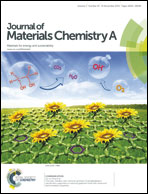Self-wrinkling induced by the photopolymerization and self-assembly of fluorinated polymer at air/liquid interface†
Abstract
Here, we investigated self-wrinkling on the surface of photo-curing systems, which comprise an acrylate cross-linker and a fluorinated copolymer. Fluorinated copolymers with low surface energy can self-assemble at the air/acrylate interface to form the top layer of the photo-curing liquid resin. The mismatch in shrinkage caused by photopolymerization between the top and bulk layer leads to the formation of a wrinkled surface. Various factors including the concentration of fluorinated polymer, photopolymerization kinetics and mechanical performance of the photo-curing systems affecting the morphology of the wrinkling were investigated systematically. The quantitative relationship between the characteristic wavelength (λ), amplitude (A) and the thickness (ht) of the top layer was obtained, and a series of submicron wrinkling patterns with wavelength between 200 and 800 nm were successfully fabricated by tuning the content of the fluorinated polymer. Furthermore, the obtained wrinkling patterned surface possesses the ability to self-replenish to some extent, which was confirmed by water contact angle (WCA) measurement and X-ray photoelectron spectrometer (XPS) spectra. This feasible one-pot approach might provide an alternative way to fabricate a patterned surface with some functionalities.


 Please wait while we load your content...
Please wait while we load your content...